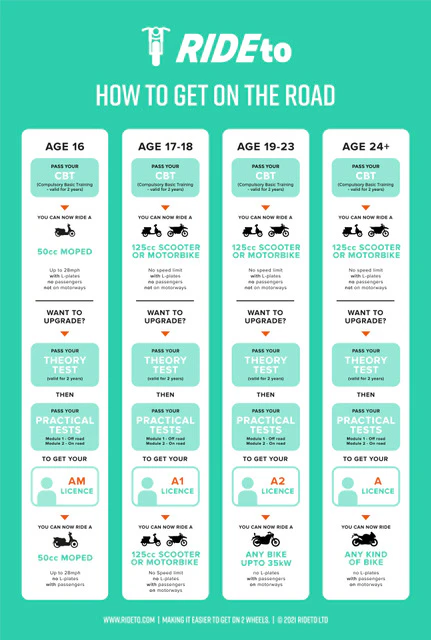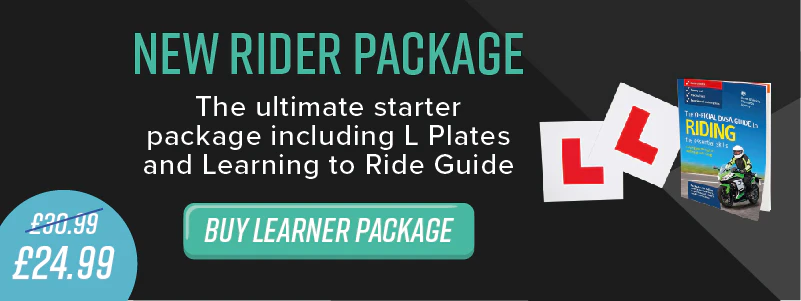back to the blog
UK Licences & Laws for Motorcycles and Mopeds

Matt D · April 10, 2017
If you want to ride and you’re starting from scratch, don’t worry, you don’t need to be an expert. We’re here to make things as straightforward and easy as possible. Below we’ve laid out all the key information you’ll want to know before getting started.
The first steps for your motorcycle licence:
- You’ll need to apply for a provisional licence from the DVLA. You can look up the details of how to do that here.
- Unless you passed your full driver's licence by February 1st 2001, you’ll need to first complete the CBT licence which is quick and easy. If you want a breakdown of how a CBT works you can read about that here.
With a CBT licence you must have your L plates visible on your bike at all times. It is also illegal to ride on motorways or carry a pillion, passengers.

Age restrictions:
Once you have your CBT you’re well on the way. However, what you can do with this licence will depend on your age:
Aged 16:
You can ride - Moped or scooter up to 50cc – max speed 45 km/h - As with all CBT qualifications you will have to ride with your L plates.
17 or over:
You can ride - Motorcycle up to 125cc (11 kW max) L plates needed.
So there are the restrictions on what you can ride, we compiled a list of our favourite recommendations for both 50cc and 125cc bikes if you’re still deciding!
Getting further UK motorcycle licences:
Once you’ve completed your CBT you’re free to move onto your full licence! There are a few options here so read through them below and decide which one is best for you:
AM Moped Licence
At 16 after passing your CBT you can take this to remove your L plates and carry passengers. The process requires you to pass a theory test and a 2 stage practical test.
A1 Motorcycle Licence
At 17 this licence means you can ride a 125cc with a maximum power output of 11Kw and carry passengers and ride on motorways without L plates. To get this licence there are 2 tests, module 1 and module 2 - This will take around 2 days to complete. Module 1 lasts about 15 minutes and Module 2 test lasts around 50 minutes on the road.
A2 Motorcycle Licence
The A2 is a similar process to A1 and if you are between 19 and 24 this is the route we would recommend. This licence allows you to ride any size bike however it must be restricted to no more than 35Kw (47bhp) and have the power to rate ratio which is no more than 0.2 Kw. This will mean you can carry passengers and ride on motorways.
A - Unrestricted Motorcycle Licence
This is the most complete licence you can get. It means you are free to ride whatever takes your fancy. Obviously, to get this licence there are restrictions in place:
To apply for this licence you must either be:
- 21 having held an A2 licence for 2 years or more.
- 24 or older.
You must take your test on a motorcycle with 595cc minimum (40 Kwh). This licence gives you the freedom to ride whatever motorcycle you want, no matter how powerful.
If you want more info on the different types of licences available we have an article on that here.
What Can I Do With A Car Driving Licence?
This is another common question. In short, it will depend on when you passed your test. So the dates matter! Here’s the breakdown below:
Car driving test passed on or after 1 February 2001:
Unfortunately, this won’t help you with bypassing any tests. You will have to complete the CBT in order to ride a bike. But on the plus side, you’re starting in a really strong position! You have a good understanding of the road and of driving theory. You should be able to pick things up quicker as you already know the basics.
Car Driving Test Passed Before 1 February 2001:
Lucky you! You’ve got a head start. You can ride a moped (max 50cc) without L plates! If you want to upgrade to a 125cc however you’ll have to take a CBT. We would always recommend the CBT, it gives you a good understanding, a reminder of all theory and just as importantly, the confidence to get on a bike!
What documents do you have to have?
There are three documents you will have to get if you wish to ride a motorcycle. Here they are:
1. Vehicle Registration Document (VRD)
This contains your name, address and details of your motorcycle.
If your bike is new then the dealer will register you with the DVLA. However if you get your bike second hand you will have to register it. The process is straight-forward and you just need to follow the DVLA guide.
2. Motorcycle Tax
Having a valid tax disk and displaying it is a legal requirement within to UK. If you are planning on keeping to a 125cc motorcycle or lower, this will only cost £17 a year.
3. Motorcycle MOT
If your motorcycle is 3 years or older you will have to take your motorcycle to a garage once a year to have an MOT carried out. This is essentially just to check that everything is working as it should and that nothing is dangerous or in desperate need of repair.
Are there any other things you need to ride a motorcycle?
Motorcycle Insurance:
You legally have to have insurance in the UK. We have included more info on this in our article here. The cost can vary depending on a number of different things. Theft is the one of the main criteria for insurance companies. So if you can ensure that your motorcycle can be put away safely then your quote will likely be a lot lower.
The Motorcycle Gear:
The final thing you will need to organise before you’re free to cruise is the gear. Having a helmet is an absolute necessity but will most likely cost less than you think. However don’t go too cheap, this is the most important items of clothing you can wear!
In line with government regulations, all helmets worn on UK roads must meet one of the following:
- British Standard BS 6658:1985 and carry the BSI Kitemark
- UNECE Regulation 22.05
- a European Economic Area member standard offering at least the same safety and protection as BS 6658:1985, and carry a mark equivalent to the BSI Kitemark
If you would like more information on this it’s worth reading the official gov.uk summary on helmet guidelines here.
Also make sure it’s comfy! We would suggest giving it a try before you buy. We’ve gone into more detail on our helmet recommendations here if you want to start exploring.



